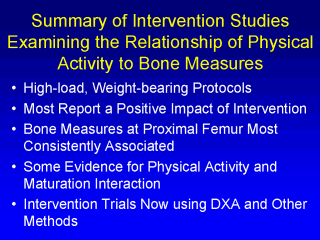 |
In
general, intervention studies support observational work and indicate the positive effects
of high impact load physical activity on bone mass during the peak bone mass accrual
period. Most of the exercise interventions have been modest in duration and frequency and
provided high impact loads via jumping. The proximal femur was the site most consistently
affected which is logical since jumping would provide a direct load to the femur. There
appears to be little gender-related difference in outcomes. Few studies have examined
effects of exercise between pre-pubescent, pubescent and post pubescent children and
adolescents, so it is difficult to conclude if puberty influences the intervention,
although there is some research to suggest this may be the case (13). Most intervention
studies now use multiple methods for measuring bone including pQCT. 13. Witzke KA, Snow CM. Effects of plyometric jump training on bone
mass in adolescent girls. Med Sci Sports Exerc 2000;32:1051-1057. |
